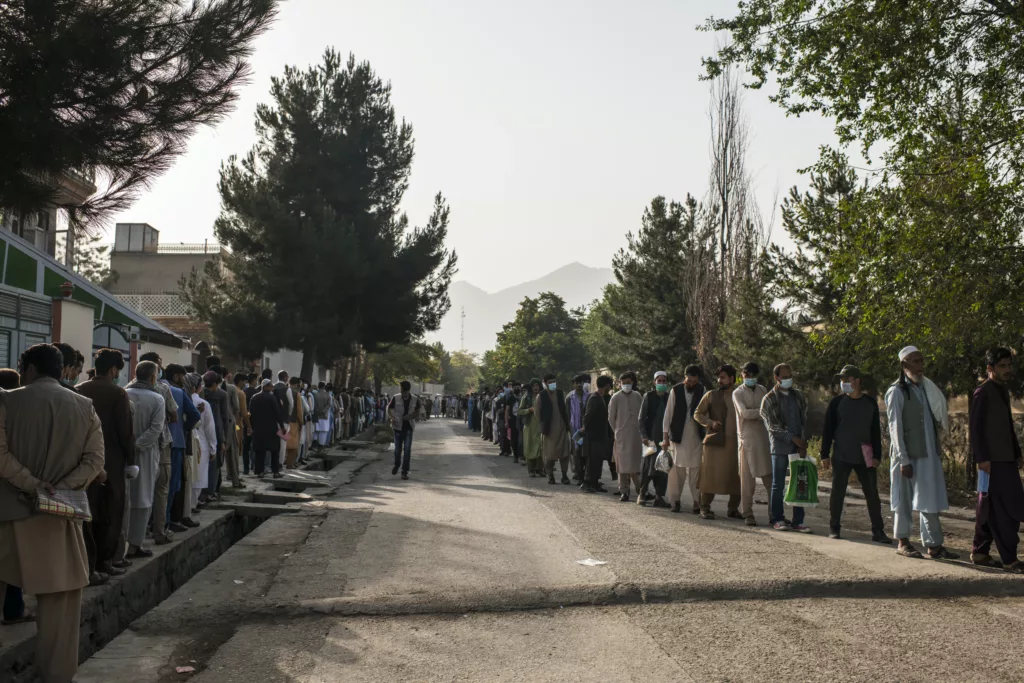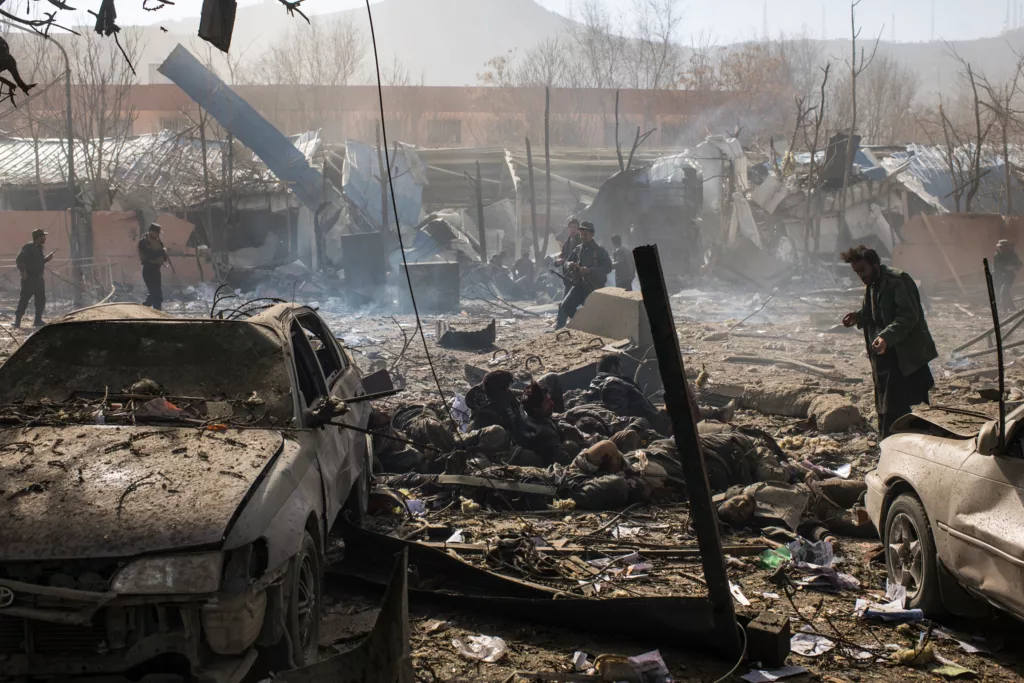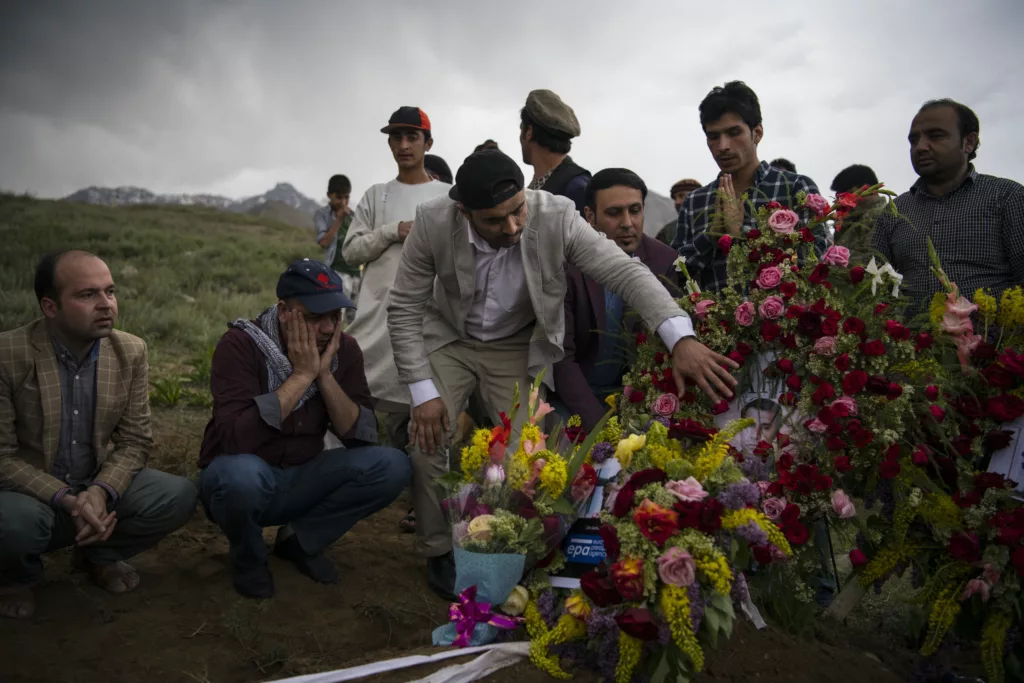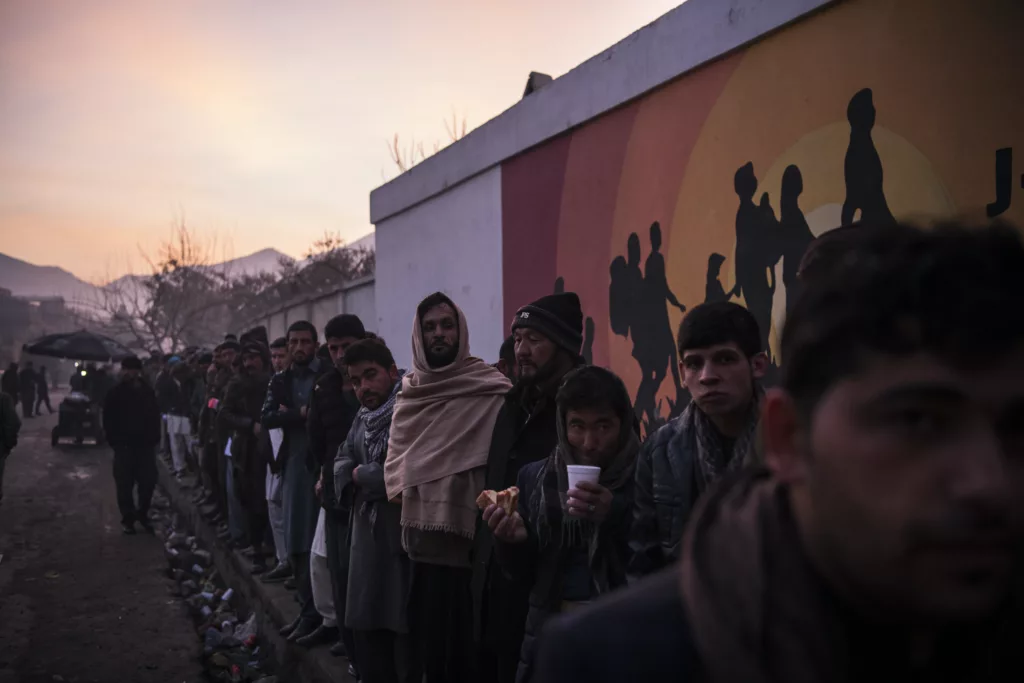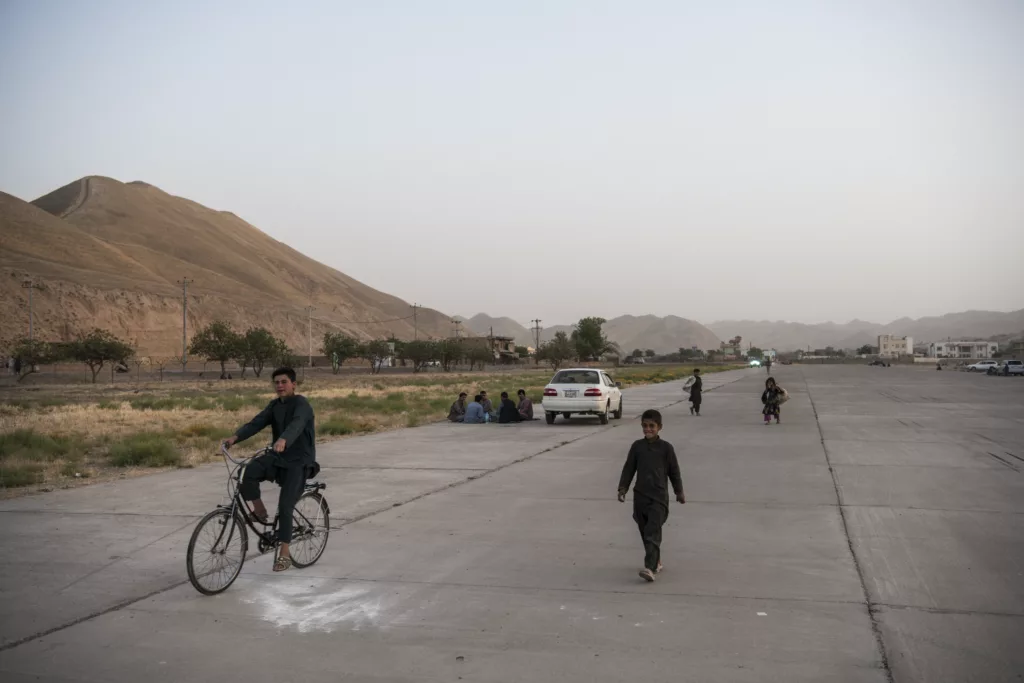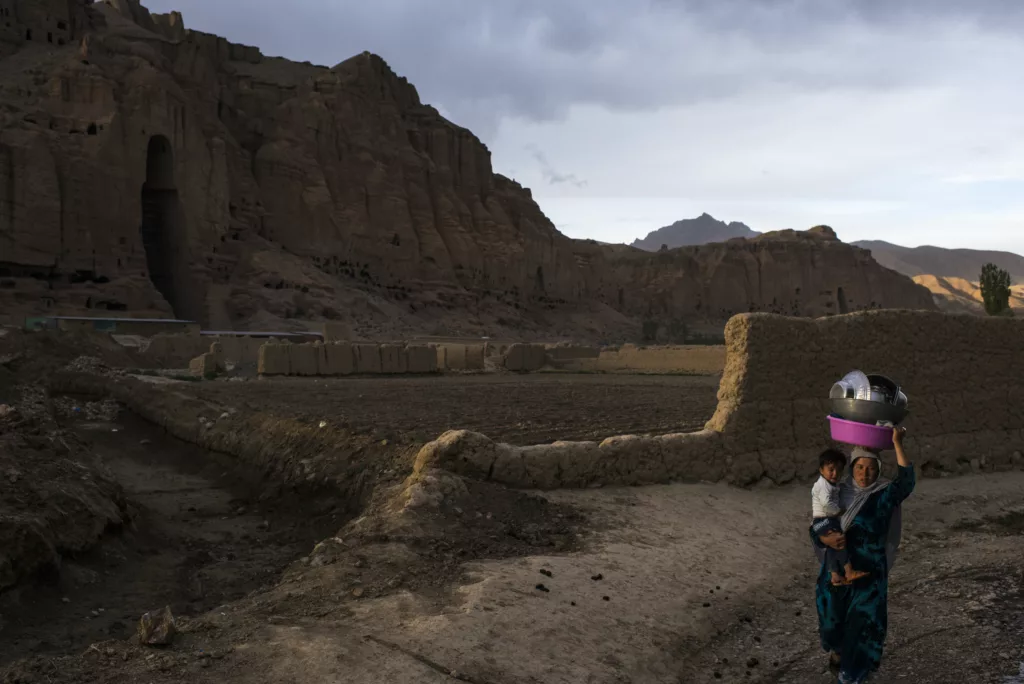Afghanistan: No Exit
CENTRAL ASIA, 16 Aug 2021
Andrew Quilty | The Intercept - TRANSCEND Media Service
12 Aug 2021 – As the Taliban Seize Cities, Desperate Afghans Are Trapped in an American-Made Fiasco
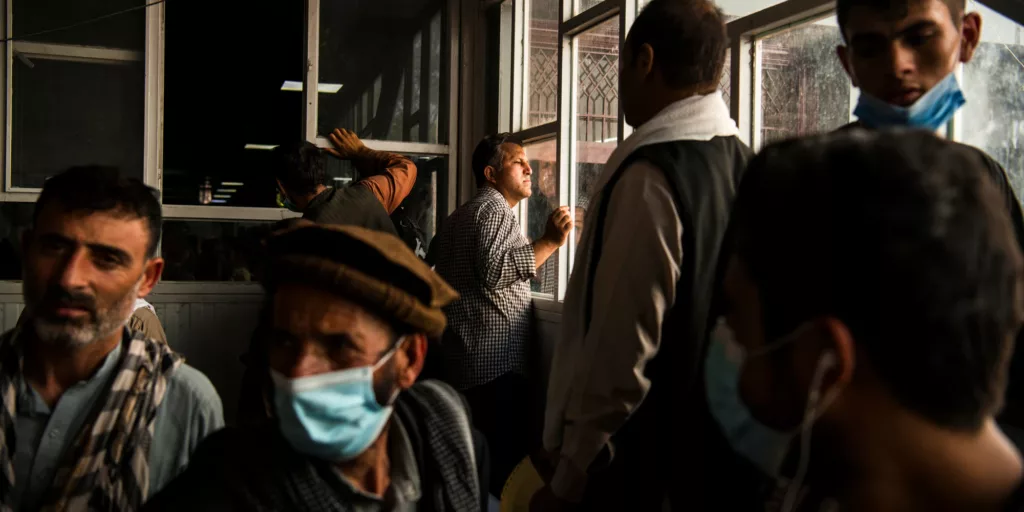
Hundreds waited inside Afghanistan’s only passport office in Kabul on July 17, 2021, hoping to secure travel documents that could help them leave the country. Photo: Andrew Quilty
1.
Afghan friends and colleagues began asking for help leaving the country in June. The requests were nothing new, but in the past they’d mostly been in jest. Now they were serious and urgent. The people who made them weren’t just seeking a better life but refuge.
The man who manages the house where I live in Kabul was among the first to ask. He had worked at three iterations of the house for more than a decade, doing maintenance and looking after the property and guests when my housemate and I were traveling. He’d started in the job long before I arrived and had become a familiar fixture in one of a shrinking handful of Kabul houses where visiting journalists, filmmakers, and researchers could rent a room. We’d been forced to move twice: When our first house was destroyed by fire in 2018 and a year later, when a second place was found to be on a supposed Islamic State target list. Both times the house manager, who I’ll call Wali to protect his identity, moved with us, along with a cleaner, an occasional gardener, half a dozen ducks, and the two dogs Wali had brought in from the street as puppies early on.
Paying electric bills, repairing leaking roofs, and buying firewood for a bunch of freelance journalists could hardly be considered the work of an “American stooge,” but Taliban fighters in Wali’s home village in a rural area north of the city were angered that he was working with foreigners. “My brother told me I should not come to the village anymore,” Wali confided in June. If the Taliban took control of Kabul, he said, he wouldn’t be safe there either.
Our proximity to war determines how deeply it affects us. I’ve lived and worked as a photographer and writer in Kabul for nearly a decade, but my connections to the city are through friends and memories rather than family or heritage. As long as airlines are flying, I can board a plane anytime and leave. Like all visitors, I’ve been privileged to live with a sense of detachment that has always allowed me to view events in Afghanistan as stories, not as life.
The shift in the war’s dynamics in recent months — American troops leaving, the Taliban surging toward the capital as the government struggles to hold them back — has altered many Afghans’ proximity to the war. It has also altered mine. Around 230 of the country’s roughly 400 districts are now in Taliban hands. Most provincial capitals, including Kandahar in the south and Mazar-i Sharif in the north, are surrounded. The first to fall, on August 6, was Zaranj, the capital of Nimroz province in the remote southwest. By Thursday, at least 11 were in Taliban control, including Herat, a major western city near Afghanistan’s border with Iran. I’d seen the Doha Agreement that set the terms of the U.S. withdrawal as the Americans’ parting gift to the Taliban, giving the insurgents little incentive to halt their military advance. As a senior Taliban military commander told me last year, an end to Taliban violence would only come in exchange for a full government surrender.
But even I hadn’t anticipated they would advance so quickly.
The risks associated with a Taliban takeover for people like Wali are real, whether they materialize or not. I described his circumstances to a Taliban source with whom I chat regularly about topics ranging from dating to war crimes. “It is a very sad situation,” the Taliban member told me, adding that Wali was right to be worried. But, he said, “it depends on the local Taliban intelligence commission. If they don’t have any issue with him no one will say anything to him. Taliban won’t kill everyone.”
Before dawn one day in July, Wali, his wife, and their three children joined the queues that snake through backstreets to Afghanistan’s only passport office. After the half day it took to lodge their application, they returned at dawn a week later, queued outside through a summer storm and submitted to fingerprinting and retina scans.
Acquiring an Afghan passport is almost guaranteed for those who apply. But a passport is only as useful as the visas inside, and the gates to the most desirable countries are now more closely guarded than ever, with several European countries warning the bloc’s executive against halting the deportation of Afghans amid the current crisis. Even a passport devoid of visas, several applicants told me, provides a sense of progress toward getting out through official channels, regardless of whether it’s realistic. Most will likely end up trying to take treacherous routes west, piling into crowded pickup trucks for a long drive through desert borderlands, over mountain passes, into Iran and on to Turkey and, if possible, beyond. Many will ultimately risk perilous journeys by boat toward Europe. In July, at least 30,000 Afghans were already leaving each week. Margo Baars, the International Organization for Migration’s deputy country director in Afghanistan, told me that figure is “presumably rising,” as is internal displacement. “Previously, it was mostly young men,” Baars said. “Now it’s families. That’s desperation.”
With the help of former housemates, I had already started compiling a small stack of documents attesting to Wali’s work over the years. I consulted two friends who served as judges in a European court that rules on asylum claims. Such evidence, they agreed, could help him secure refugee status. Whether such informal affiliations with foreigners would convince the embassy of a Western country to grant him a visa, however, was unlikely.
2.
I’ve long since lost count of the number of bombings I’ve covered in Kabul. At those grisly scenes, I’d encounter Afghan photographers and journalists working for international wire services and local outlets, some of whom became friends, and some of whom were subsequently killed or hurt, more than once while covering such attacks. I’d usually find out while scrolling through a messaging group and coming across a photo of their faces, protruding from the collars of blue flak jackets, covered in grey dust, or via a panicked phone call. I’d interact with them in their professional capacities, just as I had with photographers covering dull news conferences and sporting events at home in Sydney. For the Afghan journalists, though, the bombings were not just stories but also the deaths of their countrymen and women — and often their family and friends. I was close by when a bomb killed more than 100 people on a brisk winter’s day in 2018. I’d tied makeshift tourniquets around shredded legs and felt a man’s exposed brain on my palm while helping carry him to a nearby hospital. Afterward, a street vendor poured water over my hands and watched the watery blood trickle onto the pavement.
For 20 years, the war has disproportionately affected rural Afghans, who are less likely to have formal connections to the government and are generally less educated and more conservative. Civilians in these areas have grown accustomed to navigating shifting front lines and complex battlefield dynamics, along with more existential fears of death and displacement due to ground offensives, aerial bombing campaigns, and night raids. In many cases, aside from the initial violence required for the Taliban to take control and implement their harsh interpretation of Sharia, or Islamic law, their arrival was a mere formality. Rural Afghans have also seen the fewest benefits from the U.S.-led intervention.
What has changed with the hasty departure of American forces and air power is the kind of Afghans who are facing Taliban and government violence and the existential questions it poses in the absence of international protection. As the front lines converge around provincial capitals, those who lived under Taliban control or near front lines before the countrywide offensive began in May are almost certainly living more peacefully than at any time since 2001, because their villages are not battlegrounds any longer. For Afghans in cities, and especially in Kabul, the war has been felt only through isolated attacks, though they have been large and bloody. Partly because of the media’s concentration in the capital, news coverage can make Kabul seem eternally in flames. In truth, it has rarely felt like a war zone for more than a couple of hours at a time. (The city’s Hazara population is an exception; the ethnic minority have been ruthlessly targeted, ostensibly by the Islamic State, since 2015).
Since 2001, urban Afghans have enjoyed a return of ordinary freedoms, opportunities to flourish and, with the war at a mostly manageable distance, a semblance of peace. They threw their weight behind the post-2001 order largely for pragmatic reasons: It gave them a reliable government, police, or army salary with which to build a home or raise a family. The more cynical used the international funds, laundered through various public, nongovernmental, and business entities, to build fortunes and power. There were also idealists who saw potential and hope in a new beginning, and refugees and exiles who came home, rejecting religious fanaticism, challenging conservative cultural norms, and embracing progress. Now they have the most to lose.
A portion of this group also constitutes one side in a clash of reciprocal resentment with the uneducated, rural working class, whom urbanites tend to view as broadly complicit with Taliban fighters who control their areas. Conversely, many rural Afghans resent city dwellers and government officials, whom they perceive (correctly) to have disproportionately benefited from the post-2001 order.
Even though most of my friends and colleagues are from Afghanistan’s cities, I’ve always empathized with rural communities, which are generally scornful of both sides in the war. Early this summer, though, I began to sense my sympathies shifting toward urban Afghans as the war rolled inexorably closer. “This is now a different kind of war, reminiscent of Syria recently or Sarajevo in the not-so-distant past,” Deborah Lyons, the United Nations’ top representative in Afghanistan, told the U.N. Security Council recently.
The atmospheric change in Kabul has been swift. When May 1, the date by which international forces were to have withdrawn under the Doha Agreement, came and went without the Taliban’s promised violence, I felt an unfamiliar sense of relief. But we knew it couldn’t last. A joke with a friend who hadn’t shaved in a few days about preparing for the coming Taliban, who often require men to wear beards, no longer seems appropriate. I started feeling more guilty than usual asking Afghan friends at social events to speak in English. I congratulated a friend after hearing he’d fallen in love, knowing his partner had decided she would leave the country while he wouldn’t do so without his siblings. I blink away tears speaking with local friends at summertime soirées, the kind that used to be carefree occasions but that have started to feel more like peremptory wakes for the country as we knew it. At one gathering, I sat cross-legged on the grass with two women, one working in education and the other with the U.N., as they described the conflict between their desire to stay and keep working and that of their parents, who had seen how young, forward-thinking women were disposed of at the intersections of earlier conflicts.
Foreign journalist colleagues who live in Kabul and I cringe when journalists who have flown in specifically to cover the U.S. and NATO departure say they feel “excited” to be here. I glance around to make sure no Afghan friends are in earshot.
Discreet conversations about the success or failure of Afghan friends’ visa applications occur daily. The U.S. and U.K. governments recently announced the broadening of entrance criteria for Afghans who worked alongside their citizens. The French embassy also provided visas for several hundred who worked with French organizations, sparking a race to apply. For those who don’t qualify for such programs but have tens of thousands of dollars to spare, Turkish residency permits are available to anyone willing to buy property. Others, whose costly visa applications for the same country have been declined, are paying profiteering brokers several thousand dollars each to secure a visa or calling on foreign friends to petition embassies on their behalf.
These entreaties rarely succeed. A representative of one European country in Kabul told me they were being “extremely restrictive.” Even “staff and [their] family members” from their delegation in Kabul weren’t getting visas.
3.
A peeling mural on the wall of the Afghan passport office depicts a row of stooped figures, silhouetted against a crepuscular sky, trudging toward the edge of a cliff. Beside them, a message in Dari reads: “Don’t risk your life and that of your family. Migration is not the answer.”
When I visited the office one morning last month, a man named Habibullah told me he had been waiting in line with his three young children since 5 a.m. He had no specific reason to fear for his safety or that of his family, but he wanted to be prepared in case they had to leave. “The situation is getting worse,” he said. “There is no hope for the future. If the Taliban take control, we don’t know what kind of education system [they will permit].” Many government officials have dual citizenship, he said, and so have no incentive to fix the country’s problems. “We don’t believe them,” he said. “This is why people in Kabul are preparing in some way to leave.”
Another man, Abdul Jamil, drew me aside. He told me he had four children and produced a document indicating his “confirmation of service” as a driver for a logistics company inside Bagram Airfield, the largest U.S. military base in Afghanistan, from which the last American troops withdrew under cover of darkness, without telling their Afghan partners, in early July. “I’ve been receiving phone calls and text messages. I don’t know who is behind the curtain, but they keep sending me messages: ‘You worked with the Americans, and I will kill you.’”
The police had warned me not to take photographs. I asked to be allowed inside the passport office to seek permission from the director, at whose request I’d obtained a letter from the Ministry of Interior Affairs, but the police wouldn’t let me pass. After two hours, when the officers who’d been blocking my entry turned their backs, a couple of men and I hurried under the barrier and disappeared into the crowd.
The lines outside had been patient and orderly, but inside, it was chaos. I found the director, Muslima Amini, flanked by a few police, trying in vain to keep passport applicants at bay. What seemed like thousands of people were inside: waiting in a queue that traversed a quadrangle, sitting despondently in the sweltering heat, or ducking the swinging rifle butts of overwhelmed police in the hope of completing another step in the process.
Further inside, at 10 a.m., a young man spoke to me in English. “I came around 3:30 a.m., but still we’re waiting,” he said over the clamor of voices echoing off the steel roof. “Those who have connections are going inside, they will do their biometrics and get their passports. Those with no connections will wait in the line for a long time. Now they’re saying some people should go home and come back after Eid.”
I ran into a passport official who’d helped me for years with my own visa applications. More than 5,000 people were applying for passports each day, he said. “The situation is out of control,” he told me over voices yelling for his attention.
4.
I spent the month of June flying from one province to another to work on photographic assignments that had been arranged weeks in advance and had little to do with the Taliban’s rapid advances.
In the small capital city of Badghis, Qala-i-Naw, where I hoped to illustrate the drought that was gripping the country’s northwest, I worked with a local radio journalist whose wife and three daughters were visiting from Herat, three hours through Taliban territory to the south, where they’d lived in a kind of soft exile since security in their hometown worsened a couple of years earlier. On a Friday — the first day of the Islamic weekend — instead of driving to a favored local picnic spot outside the city which was no longer safe, we joined groups of men and bicycling children on the city’s infrequently used airstrip.
A short drive away, at the radio station, two young women were preparing for a broadcast. “I have $1,000 to upgrade the studio,” the journalist, who asked not to be named because he fears his work could make him a Taliban target, told me. “But I’m waiting to see what happens.”
Two weeks later, Taliban fighters entered Qala-i-Naw on motorcycles, freeing scores of prisoners from the city jail and trading fire with government forces in the streets. The assault had come with so little warning that the journalist, with whom I was communicating by phone, could only shelter in a friend’s home with his family, where he would not be suspected of hiding if the Taliban seized the city.
By the following morning, government forces had driven the Taliban out. Not wanting to take any further chances, the journalist and his family set off down a remote highway under Taliban control, hoping to reach Herat. The studio in Qala-i-Naw was intact, but in nearby Qadis district, which the Taliban had also overrun, they “broke our door and windows and took some assets,” he told me.
On August 1, he texted me from Herat that the “situation is getting worse day by day. Fortunately I am still fine.” After the Taliban seized Herat on Thursday, he told me he was safe but that “all media stopped their activity,” and he didn’t know what would happen next.
In Lashkar Gah, the capital of Helmand province, a friend was trying to escape the city with his family the same day a private hospital was partially destroyed when an Afghan war plane targeted Taliban fighters the government says were inside. (Hospital staff disputed that Taliban were present.) “I am fine,” he told me via WhatsApp, but “the situation is critical.”
The friend, who works with an international humanitarian organization, was hoping to reach Kandahar, where he could catch a flight to Kabul. But Kandahar’s airstrip had been damaged by rocket fire and was closed to flights. He decided to turn back, driving west through the desert to the desolate, windswept province of Nimroz in 110-degree heat. There was an airport there too. He and his family got a flight on August 2, days before the Taliban swept in and took control of the provincial capital, virtually unopposed.
5.
On another June assignment, I accompanied a French journalist, Solène Chalvon, to Bamiyan province, in Afghanistan’s Central Highlands, to work on a story about archaeology. Bamiyan is famous for the towering 6th and 7th-century Buddha statues that were destroyed by the Taliban before the U.S. invasion in 2001. Its population is mostly made up of Hazaras, a Shia minority long tormented by the Taliban, but in the last 20 years, Bamiyan has consistently been one of the most peaceful places in the country.
Even there, however, the mood had shifted. The Taliban hadn’t yet invaded the province, but they controlled all routes in and out. Older residents — who recalled their brutal intrusion in 2000, the massacres, and destruction of the Buddhas — were weighing whether to take up arms or, as they say in Afghanistan, “go to the mountains” to hide out.
A Bamiyan tour guide I’d met in 2015, and with whom I’d worked and grown friendly since, dismissed our suggestion that he return to Kabul with us by air. He couldn’t leave his mother behind, he said. Twenty-one years ago, she had been fleeing with others toward Baba Mountain, one of the highest peaks visible from Bamiyan’s central valley, with the then-infant tour guide in her arms, when a Taliban bullet struck her leg. She was unable to find medical treatment for weeks; her leg decayed and eventually, the tour guide recalls, dropped off. Now widowed, she relies almost entirely on her son to survive.
A week after Chalvon and I returned to Kabul, districts bordering Bamiyan began falling to the Taliban. Our friend told us he was packing the family’s house and planning to drive west to the more easily defensible Yakawlang valley. By July 10, two districts in the north of Bamiyan fell. In the middle of the night on July 12, he messaged to let me know that he couldn’t sleep. A checkpoint 30 miles north had fallen to the Taliban. For a day afterward, Chalvon’s and my calls and messages went unanswered. He had run the risk of driving through Taliban-controlled territory, fearing that, if fighters identified him at a checkpoint, he wouldn’t be allowed to pass because of his work with foreigners. At last, he made it safely to Kabul with his mother, his wife, and their two infant children. They joined the queue at the passport office the next day.
In the weeks since, as some of the territory overrun by the Taliban in Bamiyan was retaken by government forces, and the tour guide and his family contemplated returning home, his mother-in-law and several other relatives applied for Iranian visas. She told her daughter — the tour guide’s wife — that their visas had been issued; they had not. The group traveled to Nimroz, along the border with Iran, where they admitted by phone that their applications had been rejected. Instead, they said they had found a smuggler and planned to cross into Iran without documents. “They told me, ‘Everything is OK and lots of people are here and going to Iran,’” the tour guide said. “But it wasn’t.”
They reached a wall dividing the two countries in the early morning on the back of a pickup truck crammed with other asylum-seekers. The smuggler seemed uncertain but told the group to climb over. Someone else would collect them on the other side and take them further into Iran.
Only steps across the border, Iranian security forces fired on the crowd. Many were struck, including the tour guide’s mother-in-law, as his own mother had been 20 years before.
Half an hour later, she was dead.
Tags: Afghanistan, CIA, Central Asia, Drones, Geopolitics, Hegemony, Human Rights, Imperialism, International Relations, Military, NATO, Occupation, Pentagon, State Terrorism, USA, Violence, War on Terror
DISCLAIMER: The statements, views and opinions expressed in pieces republished here are solely those of the authors and do not necessarily represent those of TMS. In accordance with title 17 U.S.C. section 107, this material is distributed without profit to those who have expressed a prior interest in receiving the included information for research and educational purposes. TMS has no affiliation whatsoever with the originator of this article nor is TMS endorsed or sponsored by the originator. “GO TO ORIGINAL” links are provided as a convenience to our readers and allow for verification of authenticity. However, as originating pages are often updated by their originating host sites, the versions posted may not match the versions our readers view when clicking the “GO TO ORIGINAL” links. This site contains copyrighted material the use of which has not always been specifically authorized by the copyright owner. We are making such material available in our efforts to advance understanding of environmental, political, human rights, economic, democracy, scientific, and social justice issues, etc. We believe this constitutes a ‘fair use’ of any such copyrighted material as provided for in section 107 of the US Copyright Law. In accordance with Title 17 U.S.C. Section 107, the material on this site is distributed without profit to those who have expressed a prior interest in receiving the included information for research and educational purposes. For more information go to: http://www.law.cornell.edu/uscode/17/107.shtml. If you wish to use copyrighted material from this site for purposes of your own that go beyond ‘fair use’, you must obtain permission from the copyright owner.
